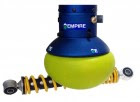LATEST NEWS
A smart-object recognition algorithm that doesn’t need humans
| January 17, 2014 |
 | BYU engineer Dah-Jye Lee has created an algorithm that can accurately identify objects in images or video sequences — without human calibration. “In most cases, people are in charge of deciding what features to focus on and they then write the algorithm based off that,” said Lee, a professor of electrical and computer engineering. “With … more… |
The brain can process images seen for just 13 milliseconds
| January 17, 2014 |
 | MIT neuroscientists have found that the human brain can process entire images that the eye sees for as little as 13 milliseconds — the first evidence of such rapid processing speed. That speed is far faster than the 100 milliseconds suggested by previous studies. In the new study, which appears in the journal Attention, Perception, … more… |
Google’s smart contact lens project could allow diabetics to track glucose levels automatically
| January 17, 2014 |
 | To help people with diabetes face as they try to keep their blood sugar levels under control, Google is testing a smart contact lens designed to measure glucose levels in tears. It uses a tiny wireless chip and miniaturized glucose sensor that are embedded between two layers of soft contact lens material, according to Google … more… |
Evidence that photosynthesis efficiency is based on quantum mechanics
| January 17, 2014 |
 | Light-gathering macromolecules in plant cells transfer energy by taking advantage of molecular vibrations whose physical descriptions have no equivalents in classical physics, according to the first unambiguous theoretical evidence of quantum effects in photosynthesis, published in the journal Nature Communications (open access). The majority of light-gathering macromolecules are composed of chromophores (responsible for the color … more… |
Directly imaging and analyzing planets around other stars: first light
| January 16, 2014 |
 | After nearly a decade of development, construction and testing, the world’s most advanced instrument for directly imaging and analyzing planets orbiting around other stars is pointing skyward and collecting light from distant worlds. “Even these early first-light images are almost a factor of 10 better than the previous generation of instruments. In one minute, we … more… |
Discovery of quantum vibrations in microtubules inside brain neurons corroborates controversial 20-year-old theory of consciousness
| January 16, 2014 |
 | A review and update of a controversial 20-year-old theory of consciousness published in Elsevier’s Physics of Life Reviews (open access) claims that consciousness derives from deeper-level, finer-scale activities inside brain neurons. The recent discovery of quantum vibrations in microtubules inside brain neurons corroborates this theory, according to review authors Stuart Hameroff and Sir Roger Penrose. … more… |
Life on other planets could be far more widespread
| January 16, 2014 |
 | Earth-sized planets can support life at least ten times farther away from stars than previously thought, according to researchers at the University of Aberdeen and the University of St Andrews. A new paper published in Planetary and Space Science claims cold rocky planets previously considered uninhabitable may actually be able to support life beneath the … more… |
NSA’s top secret technology can tap/infect computers even when not connected to the Internet
| January 15, 2014 |
| The NSA has used secret technology to input and alter data in computers even if they are not connected to the Internet, according to NSA documents provided by Edward Snowden, computer experts, and American officials, The New York Times revealed Tuesday. The technology uses radio signals generated in tiny circuit boards and inside USB cables … more… |
A low-cost sonification system to assist the blind
| January 15, 2014 |
 | An improved assistive technology system for the blind that uses sonification (visualization using sounds) has been developed by Universidad Carlos III de Madrid (UC3M) researchers, with the goal of replacing costly, bulky current systems. How it works Called Assistive Technology for Autonomous Displacement (ATAD), the system includes a stereo vision processor measures the difference of …more… |
World’s first $1,000 genome enables ‘factory’ scale sequencing for population and disease studies
| January 15, 2014 |
| Illumina, Inc. announced Tuesday that its new HiSeq X Ten Sequencing System has broken the “sound barrier” of human genomics by enabling the $1,000 genome. “This platform includes dramatic technology breakthroughs that enable researchers to undertake studies of unprecedented scale by providing the throughput to sequence tens of thousands of human whole genomes in … more… |
Ultrasound directed to the human brain can boost spatial resolution
| January 14, 2014 |
 | Virginia Tech Carilion Research Institute scientists have found that ultrasound directed to a specific region of the brain can boost performance in sensory discrimination. The study provides the first demonstration that low-intensity, transcranial-focused ultrasound (tFUS) can modulate human brain activity to enhance perception. “Ultrasound has great potential for bringing unprecedented resolution to the growing trend … more… |
A gripper using soft robotics
| January 14, 2014 |
 | A robot gripper invented by researchers at the University of Chicago and Cornell University is now available commercially from Empire Robotics as VERSABALL for industrial automation, scheduled to ship later in January. Company officials believe the technology might also be useful for prosthetic devices that can assist with work tasks, for in-home assistive devices, and … more… |
Wafer-scale, flexible thin-film electronics
| January 14, 2014 |
 | Researchers at ETH Zurich are developing thin-film transistors, sensors, and other electronic components that are thin and flexible enough to be wrapped around a wide range of surfaces without damaging the electronics. The aim is to weave these types of components into textiles or apply them to the skin to make “smart,” unobtrusive, comfortable sensors … more… |
Extending future electric-car battery life, range
| January 12, 2014 |
 | A hybrid anode developed at the Department of Energy’s Pacific Northwest National Laboratory (PNNL) could quadruple the life of the lithium-sulfur batteries proposed for use in electric vehicles. “Lithium-sulfur batteries could one day help us take electric cars on longer drives and store renewable wind energy more cheaply, but some technical challenges have to be … more… |
Organic flow battery promises breakthrough for renewable energy
| January 12, 2014 |
 | A team of Harvard scientists and engineers has demonstrated a new type of battery that could fundamentally transform the way electricity is stored on the grid, making power from renewable energy sources such as wind and solar far more economical and reliable. The new “flow” battery design relies on the electrochemistry of naturally abundant, inexpensive, … more… |
A theoretical metamaterial that acts as an analog computer
| January 12, 2014 |
 | Metamaterials can be designed to do “photonic calculus” as a light wave goes through them, researchers at the University of Pennsylvania, The University of Texas at Austin and University of Sannio in Italy have discovered. A light wave, when described in terms of space and time, has a profile in space that can be thought …more… |
IBM forms new Watson group for cloud-delivered cognitive innovations, with $1 billion investment
| January 12, 2014 |
 | IBM has announced it will establish the IBM Watson Group, a new business unit dedicated to the development and commercialization of cloud-delivered cognitive innovations. Headquartered in NYC’s “Silicon Alley,” the move signifies a strategic shift by IBM to accelerate into the marketplace a new class of software, services and apps that think, improve by learning, … more… |
No comments:
Post a Comment